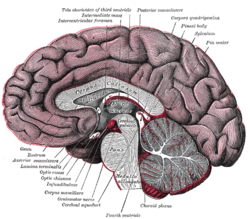Tapetum of corpus callosum
| Corpus callosum | |
|---|---|

Corpus callosum from above. (Anterior portion is at the top of the image.)
|
|

Median sagittal section of brain (person faces to the left). Corpus callosum visible at center, in light gray
|
|
| Details | |
| Part of | Human brain |
| Components | Genu, trunk, splenium |
| Identifiers | |
| MeSH | A08.186.211.730.885.362 |
| NeuroNames | hier-173 |
| NeuroLex ID | Corpus callosum |
| TA | A14.1.09.241 |
| FMA | 86464 |
|
Anatomical terms of neuroanatomy
[]
|
|
The corpus callosum (/ˈkɔːrpəs kəˈloʊsəm/; Latin for "tough body"), also callosal commissure, is a wide commissure, a flat bundle of commissural fibers, about 10 cm long beneath the cerebral cortex in the brains of placental mammals. It spans part of the longitudinal fissure, connects the left and right cerebral hemispheres, and enables communication between the hemispheres. It is the largest white matter structure in the human brain, consisting of 200–250 million axonal projections.
The posterior end of the corpus callosum, near to the cerebellum, is called the splenium. This is the thickest part, and overlaps the tela chorioidea of the third ventricle and the mid-brain, and ends in a thick, convex, free border. Splenium translates as bandage in Greek. A sagittal section of the brain shows that the posterior end of the corpus callosum is acutely bent forward, the upper and lower parts being applied to each other.
...
Wikipedia
